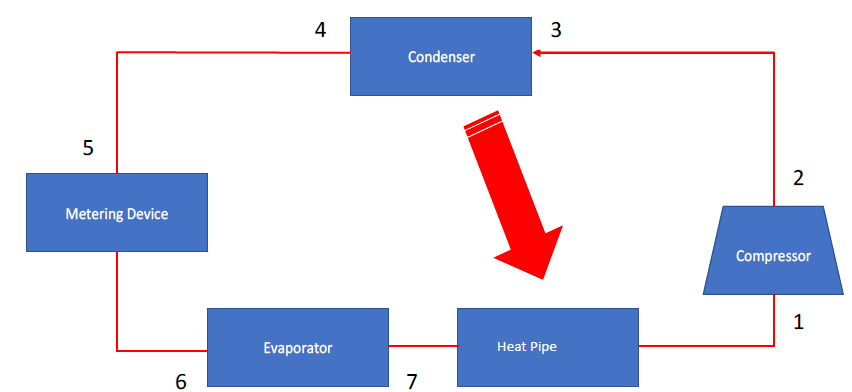Performance of Heat Pipe with Different Working Fluid on Harvesting Wasted Heat Energy at Air Cooled Split Unit
DOI:
https://doi.org/10.37934/cfdl.16.3.6981Keywords:
Air Conditioning, Heat Pipe, SuperheatAbstract
These days, life would not be comfortable without air conditioning which leads to high power consumption due to air conditioning and subsequently increases the carbon footprint. In this research, verification was done on the capability of increasing superheat to improve the performance of the air-cooled split unit and the effect of power consumed by the air conditioning system. The superheat was increased by the heat harvested from the condensing unit of the air-cooled split unit by using a heat pipe. The heat pipe was charged with water, R134a, and R600a with a 100% filling ratio and 90 and 70 inclination angles. K-Type thermocouples, pressure gauges, and power meter were used in data collection. According to data analysis, water with a 90 inclination angle of heat pipe showed the best performance compared to other fluids because of its ability to increase superheat by approximately 32% compared to R600a which increased only approximately 6.5% compared to normal conventional air conditioning. However, it demonstrated that a rise in the superheat at the suction line and a rise in the Coefficient of Performance cannot guarantee a fall in energy usage. This was due to an increase of superheat by the water heat pipe at 90 angle inclination indicating approximately a 28.8% increase in power consumption.
Downloads
References
Bernama, ‘Water purifiers among causes of high electricity bill - TNB’, Astroawani.com, May 03, 2023. https://www.astroawani.com/berita-malaysia/water-purifiers-among-causes-high-electricity-bill-tnb-285853 (accessed Jul. 31, 2023).
Anand, R. S., C. P. Jawahar, A. Brusly Solomon, and Evangelos Bellos. "A review of experimental studies on cylindrical two-phase closed thermosyphon using refrigerant for low-temperature applications." International Journal of Refrigeration 120 (2020): 296-313. https://doi.org/10.1016/j.ijrefrig.2020.08.011
Li, Danny HW, Liu Yang, and Joseph C. Lam. "Impact of climate change on energy use in the built environment in different climate zones–a review." Energy 42, no. 1 (2012): 103-112. https://doi.org/10.1016/j.energy.2012.03.044
‘Energy Data Explorer - Our World in Data’. https://ourworldindata.org/explorers/energy?tab=chart&facet=none&country=~MYS&Total+or+Breakdown=Total&Energy+or+Electricity=Primary+energy&Metric=Annual+consumption (accessed Mar. 13, 2022).
Chua, Kian Jon, Md Raisul Islam, Kim Choon Ng, and Muhammad Wakil Shahzad. "Advances in air conditioning technologies." (2021). https://doi.org/10.1007/978-981-15-8477-0
Takane, Yuya, Yukihiro Kikegawa, Masayuki Hara, and C. Sue B. Grimmond. "Urban warming and future air-conditioning use in an Asian megacity: importance of positive feedback." npj Climate and Atmospheric Science 2, no. 1 (2019): 39. https://doi.org/10.1038/s41612-019-0096-2
Yusof, Mohd Hazwan, Sulaiman Mohd Muslim, Muhammad Fadhli Suhaimi, and Mohamad Firdaus Basrawi. "The effect of refrigerant charge and outdoor temperature on the condenser and evaporator of a split-unit type air conditioner using R22 refrigerant." In MATEC Web of Conferences, vol. 225. EDP Sciences, 2018. https://doi.org/10.1051/matecconf/201822502013
Sunu, Putu Wijaya, D. A. Simon, I. M. Rasta, Y. B. Lukiyanto, I. D. M. Susila, and I. K. Suarsana. "Effect of Various Superheat Condition on Working Condition of Air Cooled Chiller." In 2018 International Conference on Applied Science and Technology (iCAST), pp. 708-711. IEEE, 2018. https://doi.org/10.1109/iCAST1.2018.8751585
Ardita, I. N., and I. G. A. B. Wirajati. "The effect of changing superheat degrees on energy consumption in a split air conditioning." In Journal of Physics: Conference Series, vol. 1450, no. 1, p. 012091. IOP Publishing, 2020. https://doi.org/10.1088/1742-6596/1450/1/012091
Al-fahham, Mohamed, Adel A. Eidan, Ahmed Qasim Ahmed, and Assaad AlSahlani. "Improving the performance of air conditioning system experimentally by a new type of heat pipe heat exchanger." In IOP Conference Series: Materials Science and Engineering, vol. 928, no. 2, p. 022124. IOP Publishing, 2020. https://doi.org/10.1088/1742-6596/1450/1/012091
Al-Abidi, Abduljalil A., Sohif Bin Mat, K. Sopian, M. Y. Sulaiman, C. H. Lim, and Abdulrahman Th. "Review of thermal energy storage for air conditioning systems." Renewable and Sustainable energy reviews 16, no. 8 (2012): 5802-5819. https://doi.org/10.1016/j.rser.2012.05.030
Eidan, Adel A., Mohammed J. Alshukri, Mohamed Al-fahham, Assaad AlSahlani, and Dhurgham M. Abdulridha. "Optimizing the performance of the air conditioning system using an innovative heat pipe heat exchanger." Case Studies in Thermal Engineering 26 (2021): 101075. https://doi.org/10.1016/j.csite.2021.101075
‘NUS engineers invent hybrid air-conditioner that reduces electricity consumption - CNA’. https://www.channelnewsasia.com/singapore/nus-engineers-invent-air-con-reduce-electricity-940216 (accessed Jan. 10, 2022).
Vinson Chua, ‘Ecoline Solar Thermal Air Conditioning’, presented at the HEAT FOR A GREENER WORLD, Singapore. [Online]. Available: https://ecolinesolar.com.sg/wp-content/uploads/2020/09/Ecoline-IBEW-Webinar-2020-_Final-1.pdf
Temimy, Alaa AB, Adnan A. Abdulrasool, and F. A. Hamad. "Study of Heat Pipe Thermal Performance with Internal Modified Geometry." Fluids 6, no. 7 (2021): 231. https://doi.org/10.3390/fluids6070231
Jouhara, Hussam, Amisha Chauhan, Theodora Nannou, S. Almahmoud, Bertrand Delpech, and Luiz C. Wrobel. "Heat pipe based systems-Advances and applications." Energy 128 (2017): 729-754. https://doi.org/10.1016/j.energy.2017.04.028
Alammar, Ahmed A., Raya K. Al-Dadah, and Saad M. Mahmoud. "Effect of inclination angle and fill ratio on geyser boiling phenomena in a two-phase closed thermosiphon–Experimental investigation." Energy conversion and management 156 (2018): 150-166. https://doi.org/10.1016/j.enconman.2017.11.003
Gedik, Engin, Mustafa Yılmaz, and Hüseyin Kurt. "Experimental investigation on the thermal performance of heat recovery system with gravity assisted heat pipe charged with R134a and R410A." Applied Thermal Engineering 99 (2016): 334-342. https://doi.org/10.1016/j.applthermaleng.2015.12.075
Afolabi, Lukmon Owolabi, Oluwafunke Afolabi-Owolabi, Abdulhafid M. Elfaghi, Djamal Hissein Didane, Mohammed Ghaleb Awadh, and Al-Mahmodi Akram. "Experimental Investigation on Evacuated Tube Solar Collector Using Biofluid as Heat Transfer Fluid." Journal of Advanced Research in Fluid Mechanics and Thermal Sciences 87, no. 3 (2021): 40-50. https://doi.org/10.37934/arfmts.87.3.4050
Ersöz, Mustafa Ali. "Effects of different working fluid use on the energy and exergy performance for evacuated tube solar collector with thermosyphon heat pipe." Renewable Energy 96 (2016): 244-256. https://doi.org/10.1016/j.renene.2016.04.058
Gallego, Anderson, Bernardo Herrera, Robison Buitrago-Sierra, Camilo Zapata, and Karen Cacua. "Influence of filling ratio on the thermal performance and efficiency of a thermosyphon operating with Al2O3-water based nanofluids." Nano-Structures & Nano-Objects 22 (2020): 100448. https://doi.org/10.1016/j.nanoso.2020.100448
Ong, K. S., and Md Haider-E-Alahi. "Performance of a R-134a-filled thermosyphon." Applied thermal engineering 23, no. 18 (2003): 2373-2381. https://doi.org/10.1016/S1359-4311(03)00207-2
A. Wehrhahn, ‘Daikin Chemical Europe GmbH’, s’ s’’.
Qi, Zhaogang. "Performance improvement potentials of R1234yf mobile air conditioning system." International Journal of Refrigeration 58 (2015): 35-40. https://doi.org/10.1016/j.ijrefrig.2015.03.019




























